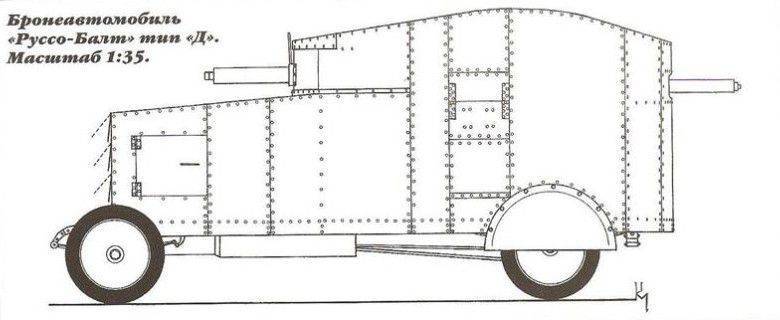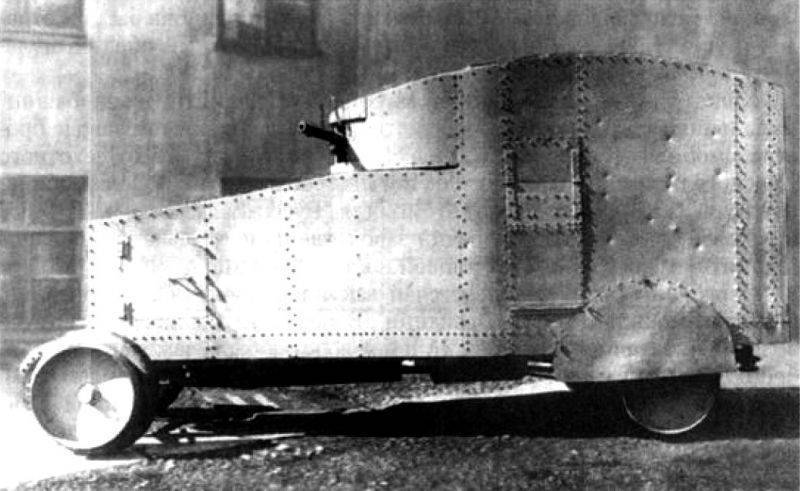Armored cars "Russo-Balt Type I" Nekrasov-Bratolyubova
To implement the plans for the construction of armored cars, seven contractors that were available were handed over to the specialist contractors. New armored cars were proposed to be built on the basis of one French-made Renault car and six Russian Russo-Balts C 24 / 40 and D models (three of each type). Having studied the characteristics of the transmitted chassis, the authors of the new projects were able to begin shaping the appearance of promising technology.
The technical task of the customer involved the creation of armored vehicles with a combined machine gun and cannon armament. It was assumed that such a technique would fight not only with infantry, but also with enemy armored vehicles. For the effective defeat of enemy armored vehicles and fortifications required appropriate weapon, which affected the composition of weapons. To combat the infantry, armored cars had to carry several machine guns, and the destruction of equipment and fortifications was assigned to small-caliber guns.
The design of the armored vehicle based on the Russo-Balt chassis has traditionally been designated by the name of the chassis, which is why this type of vehicle is often called the Russo-Balt Type C and Russo-Balt Type D. In this case, however, some confusion is possible. The fact is that some other domestic armored vehicles from the First World War bore the same names. For this reason, over time, a “neutral” version of the names appeared that did not cause confusion. In this case, the name "Russo-Balt Type C" remains behind the project of Colonel Dobzhansky, and the development of Nekrasov and Bratolyubov is called "Russo-Balt Type I". In addition, this allows you to introduce the additional designation "Russo-Balt Type II" for the later armored cars Nekrasov-Bratolyubov on the chassis of the Russian-Baltic plant, equipped with a body of a different design.
The specialists responsible for the construction of new armored cars had three Type D and Type 24 / 40 vehicles each. They were asked to remove all unnecessary details, instead of which a new armored hull should have been installed. During assembly on the chassis mounted metal frame, which served as the basis for the body. Bronelists were fixed on the frame with rivets and bolts.
The assembly of armored cars "Russo-Balt" and "Renault" was carried out in Bratolyubov's own workshops. The production capacity of this small enterprise did not allow to carry out all the necessary work, which is why the Obukhov Steel Plant was attracted to the project. Nekrasov and Bratolyubov made a set of templates, according to which factory workers produced armor plates of the desired configuration. The project "Russo-Balt Type I" meant the assembly of the body of sheets of thickness 5 mm.
All six basic chassis had a similar design. On the base frame was installed gasoline engine power up to 40 hp and manual transmission with chain drive on the leading rear axle. Machines with wheel formula 4х2 had a dependent suspension on leaf springs. Since the chassis was originally intended for passenger cars, Nekrasov and Bratolyubov had to modify them. The frames and springs were strengthened and steering mechanisms were altered. In addition, the wheels are equipped with cast tires.
Type I armored cars received an unusual design of an armored hull. Probably, the authors of the project wanted to reduce the weight of the hull and armored car, without sacrificing firepower. As a result of this, a body has appeared of a rather complex shape formed by straight and curved surfaces. Swivel tower was not provided. All the armament was to be installed in the casements, providing guidance in wide horizontal sectors.
The armored hull of the machine on the base of the Russo-Balt chassis was divided into two main volumes: the engine compartment and the combat compartment, combined with the control compartment. The engine was defended by vertical sides and a front sheet with swinging louver shutters, made in the form of separate panels. The sides provided swinging hatches for servicing the engine. The top cover was located at a noticeable angle to the horizontal. Behind the engine, the hull side panels smoothly diverged to the side, which made it possible to increase the size of the habitable compartment.

Scheme of the armored car. Figure Baryatinsky MB, Kolomiets M.V. Armored cars of the Russian army 1906 – 1917
The habitable part of the armored hull had an original shape with an unusual frontal architecture. Directly behind the engine compartment was an armored corset with vertical sides and a horizontal roof. On top of it, a semicircular curved sheet was installed with a hatch for installing weapons and observing the road. Behind the front duct, the boards diverged to the maximum distance and after that the width of the hull did not change. The fighting compartment had vertical sides and a curved stern leaf. The height of the sides was not the same along their entire length. From above, the crew defended by a curved roof with a raised middle part. On the sides were provided semicircular flaps that covered the rear wheels.
The fighting compartment had an interesting feature. To increase the level of protection of the crew, the corps received some semblance of a splinter podboy. Inside on the armor sheets secured a layer of felt and closed it with linoleum. It was assumed that such a coating armor will delay the bullet that managed to penetrate armor.
In the armored hull provided a set of hatches to enter the car, monitor the situation and install weapons. On the left side there was a narrow elongated hatch for access to the fighting compartment. Two embrasures were located in the front and aft sheets, and the feed was made in the form of a wide hatch with an inner movable flap. In addition, there are information about several other hatches for the use of machine guns.
The crew of armored vehicles "Russo-Balt Type I" was to consist of six people: the driver, the commander and four gunners. In this case, the specific composition of the crew could depend on the type of armored car and the weapons installed on it.
For several reasons, it was decided to equip the new armored vehicles with different weapons. Thus, the armored cars on the base of the Russo-Balt C chassis were proposed to equip with two guns Hotchkiss caliber 37 mm. One gun was mounted in the embrasure of the frontal sheet, the second - in the stern. The armored cars on chassis D, in turn, had to carry one Maxim-Nordenfeld stern gun of the 37 caliber mm. The additional armament of the armored vehicles was to consist of three Maxim machine guns. They were planned to be installed in various manholes of the hull.
The assembly of all the armored cars of Nekrasov-Bratolyubov’s first projects faced serious problems. Due to the large number of defects, the Obukhov plant for several months could not supply all the necessary sets of armor parts. The assembly of seven armored vehicles was completed only at the end of the winter 1915 of the year. Six Russo-Balt armored vehicles and one Renault were presented to the commission of the 23 February Main Military and Technical Directorate.

Armored car, right side view. Photo Baryatinsky MB, Kolomiets M.V. Armored cars of the Russian army 1906 – 1917
The commission, headed by Lieutenant General Mgebrov, examined the new equipment and approved the start of the tests. First, the car was sent to the landfill of the Officers' Infantry School (Oranienbaum), where it passed a weapon and protection check. One of the armored cars came under fire from a machine gun from a distance of at least 50 steps. The machine board successfully passed the test. There were dents of various sizes on the armor sheet, but there were no through holes. Weapon checks also ended in success. Guns and machine guns of armored cars effectively hit targets and fired within fairly wide sectors. For example, the design of the front embrasure allowed to direct the gun within the sector width 90 °.
The fighting qualities of the new cars were staged by the military, but the driving characteristics left much to be desired. To conduct field tests, Nekrasov-Bratolyubov’s armored cars had to be overtaken from Petrograd to Oranienbaum. This road revealed real mobility characteristics. During the haul of the car, driving on a good highway, they were speeding up to 30-35 versts per hour, but on dirt roads the maximum speed dropped significantly. Insignificant dirt on the road made it difficult for equipment to move, and on compacted sand it could even get stuck.
Acceptable characteristics of mobility on the highway were associated with increased engine load. Armored cars "Russo-Balt" and "Renault" several times faced with overheating of engines and boiling water in the radiator. Thus, even in mild highway conditions, the machines had to work at the limit.
According to the results of tests at the site and testing on the roads, the commission of the Main Military Technical Directorate decided that the new armored cars of Nekrasov and Bratolyubov could not be used for their intended purpose. Due to the significant load on the chassis, the operation of the machines at the front was not possible. The fate of seven armored vehicles became a subject of controversy.
General A.A. rescued armored cars from disassembly. Brusilov, who commanded the 8 th army. In March, 1915, he proposed to convert all the existing machines into armored tires. So it was possible to save the already built technique, as well as get rid of the problems associated with driving on broken roads and rough terrain. At the suggestion of General Brusilov, the car had to be equipped with railway wheels, designed for a European gauge. This allowed them to be used in battles in Galicia.
Soon, three armored vehicles on the Russo-Balt C chassis and the only Renault went to Moscow, where they had to undergo repairs and upgrades. The remaining Nekrasov-Bratolyubov's armored cars were transferred to one of the army units for use as training units. In the workshops of Kazan Railways, new wheels and some other equipment were installed on the cars. To test this technique prepared a special stage of a length of three miles. The project of modernization of armored vehicles was carried out under the leadership of Captain Meschereninov.
12 June 1915, the commission of General Mgebrov again examined the upgraded armored cars and concluded that the task was successfully completed. However, the car and this time did not get to the front. By the summer of 15, the Russian army began a retreat in Galicia, where new armored vehicles were to operate. The railway tracks suitable for the operation of the updated equipment remained on the territory of the enemy. In order not to abandon an interesting project, it was decided to equip the equipment with wheel pairs with a wide Russian track. At this stage, the armored car "Renault" dropped out of the project, the finalization of which was considered difficult and inexpedient.

Armored cars in the railway configuration. Photo Aviarmor.net
In July, the Russian-Baltic Carriage Works (Riga) delivered several wheel sets with the necessary parameters to the workshops of the Moscow Railway. It took several days to install them, and for the first time 9 August “Russo-Balty Type I” passed along the rails with 1524 mm gauge.
23 September three armored cars tested in conditions close to real. As part of the tests, these machines overcame more than 80 versts, driving from Moscow to st. Ramenskoye and back. The average speed during this trip was 35-37 versts per hour, the maximum speed was about 56 versts per hour (60 km / h). Re-equipment of armored cars justified itself. It was possible to begin their operation.
Shortly after a trip to Ramenskoye and back, three Russo-Balt armored cars were sent to Petrograd. There, the servicemen of the Reserve Armored Company conducted a full cycle of tests with movement on railways and highways, shooting at the range, etc. Testers noted a fairly high performance machines. They developed a good speed, could take on board the cargo, as well as be used as a tug of railway cars. Thus, during the tests, the armored cars successfully towed four platforms with a total weight of 2700 pounds (43,2 t).
In January, 1916, at the suggestion of Meshcheneninov, was formed by an Armored car and railway platoon, which included three Russo-Balt armored vehicles and several other vehicles adapted for rail traffic. A few weeks after the formation of the compound was sent to the Western Front. Details of the operation of this technology at the front are unknown. According to reports, the platoon was transferred several times to different parts of the front. The exact composition of the unit at the time of redeployment is unknown.
The armored road and railway platoon continued combat work until the end of the war. In the future, the technique of this compound went to the participants of the Civil War and with varying success was used by both parties to the conflict. According to some sources, the armored cars of the Russo-Balt Type I Nekrasov-Bratolyubov replenished the fleet of vehicles of the Red Army, however, there are no exact data on the number of these machines and the characteristics of their use.
Like many other armored cars built during the First World War, the Russo-Balt and Nekrasov and Bratolyubov vehicles of the first version were dismantled and disposed of not later than the beginning of the twenties. By this time, the machines have developed their resource, and their characteristics are not satisfied with the military. Armored cars decided to disassemble.
Based on:
http://aviarmor.net/
http://simvolika.org/
Solyankin A. G., Pavlov M. V., Pavlov I. V., Zheltov I. G. Domestic armored vehicles. XX century. - M .: Exprint, 2002. - T. 1. 1905 – 1941
Baryatinsky MB, Kolomiets M.V. Armored cars of the Russian army 1906 – 1917 - M .: Technics-youth, 2000

Information